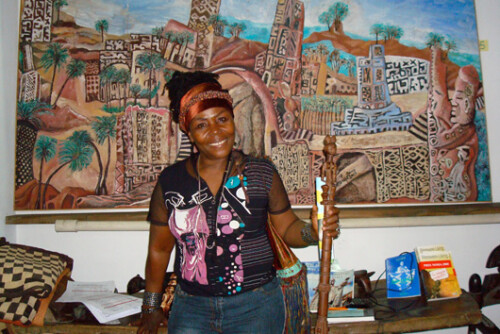A Torpid Affair
In Ugly Feelings, Sianne Ngai identifies animatedness, “the exaggeratedly emotional, hyperexpressive, and even ‘overscrutable’ image of most racially and ethnically marked subjects of American culture,” as a key representational trope and technology.13 Through a deft analysis of the animated television series The PJs, among other texts, Ngai plays with multiple meanings of “animate” and “animated”. She notes, “With both terms, we move from references to biological existence (‘endowed with life or the qualities of life: ALIVE’), to socially positive emotional qualities (‘lively,’ ‘full of vigor and spirit,’ ‘zest’), and finally to a historically specific mode of screen representation (‘made in the form of an animated cartoon’).”14 As Ngai notes, animatedness has a peculiar and problematic attachment to African-American subjects in the United States:
It is the cultural representation of the African-American that most visibly harnesses the affective qualities of liveliness, effusiveness, spontaneity, and zeal to a disturbing racial epistemology, and makes these variants of “animatedness” function as bodily (hence self-evident) signs of the raced subject’s naturalness or authenticity. Here, as epitomized in [Harriet Beecher] Stowe’s character Topsy, the affective ideologeme of animatedness foregrounds the degree to which emotional qualities seem especially prone to sliding into corporeal qualities where the African-American subject is concerned, reinforcing the notion of race as a truth located, quite naturally, in the always obvious, highly visible body.15
What happens when the animatedness so often attached to African-American subjects is markedly absent, replaced with a lack of animatedness we might call torpidity? By torpidity, I intend the double sense in which “activity, animation, or development is suspended” or “sluggish in action or function,” but also in the sense of being “benumbed” or “deprived of the power of feeling.”16 How might this attach to the racialized fat subject?
Consider the film Precious (2009) and the response its lead actor, Gabourey Sidibe, elicited from film critics. The New Yorker‘s Anthony Lane commented, “She is grimly overweight, her face so filled out that the play of normal expression seems restricted; yet Sidibe does wonders with that sad limitation, and we learn to spot the flare of anger in her eyes.”17 David Edelstein’s review in New York magazine is worth quoting at length:
I’m not judging girls who look like Sidibe in life, but her image onscreen is jarring to the point of being transgressive, its only equivalent to be seen in John Waters’s pointedly outrageous carnivals. Her head is a balloon on the body of a zeppelin, her cheeks so inflated they squash her eyes into slits. Her expression is either surly or unreadable. Even with her voice-over narration, you’re meant to stare at her ebony face and see nothing. The movie is saying that she’s not an object, but the way that Sidibe is directed she becomes one. It’s only in a couple of heavy-handed fantasy sequences (she emerges from a theater in a bright-red gown to popping flashbulbs) that her eyes are windows to the soul […] The most offbeat touch is a social worker played by Mariah Carey. She’s a tad too goody-goody, but her toasty, caressing voice is a gift beside Sidibe’s mush-mouthed monosyllables.18
In both Lane and Edelstein’s reviews, Sidibe’s fatness seems to elide the racialized animatedness, which audiences, and white audiences in particular, have come to expect from African American subjects on screen. Lane’s review gestures towards Sidibe’s ability to overcome the “sad limitation” of her own face, inviting the audience to track and hone in on the emotion that manages to break through in her eyes. Edelstein, on the other hand, finds Sidibe’s “inflated” face overwhelming, granting a strange agency to her cheeks “squash[ing] her eyes into slits.” Her face becomes an inscrutable nonreflective “ebony” surface; Edelstein “see[s] nothing.” If, according to Lane, Sidibe “does wonders” in animating her face in spite of it, she is rendered object-like by the lack of directorial animation in Edelstein’s review. For Edelstein, it is Lee Daniels, director, who fails to properly animate Sidibe. Of course, it is Edelstein’s claim itself that performs the object(ifying) move; that being said, he does understand the workings of racialized animatedness, in that he recognizes that what is required for him to grasp her as human and lifelike is, paradoxically as Ngai points out, a ventriloquist act.

Ngai notes “the extent to which animation remains central to the production of the racially marked, even when his or her difference is signaled by the pathos of emotional suppression rather than by emotional excess;” in this case, she refers to the stereotype of “the Asian as silent, inexpressive, and, like Bartleby, emotionally inscrutable.”19 It is any surprise that Lane imagines Sidibe’s eyes as “squash[ed] … into slits,” as if Sidibe’s failure to become a properly racially animated African American subject thrusts her into yet another racial and ethnic stereotype? Is emotional inscrutability for the African American subject on screen also a mode of racial inscrutability? Of course, it may be that Lane and Edelstein are simply not used to seeing an fat African American face taking up so much screen, unless of course, that face is simply functioning as a means to deliver a ventriloquized fat joke. Fat is what ultimately interrupts the usual operation of racialized animatedness, I would argue, but why and by what means? Ngai argues, “the affective ideologeme of animatedness foregrounds the degree to which emotional qualities seems especially prone to sliding into corporeal qualities where the African American subject is concerned, reinforcing the notion of race as a truth located, quite naturally, in the always obvious, highly visible body.”15 Is it possible that fat acts as an impediment to this slide in some way?
At first glance, it would seem that fat would enable this slide, as fat draws attention to the “obvious, highly visible body,” operating as the penultimate “discredited” identity in Erving Goffman’s terms—one would think that fat would only further secure the also discredited racialized body. Yet, fat seems to enact a reversal whereby corporeal qualities slide into emotional qualities, seeming to eclipse or overwhelm them. In the absence of comic relief, Sidibe frustrates the critic, becoming “unreadable.” There may be another register here that enables the corporeal to act as an impediment to the emotional, and it leads us back to the other meaning of torpidity as “sluggish in action or function.” or suspended “activity, animation, or development.” Edelstein’s review’s subheading, “The violent and shocking Precious should be more moving than it is,” gestures toward what should be innervating, activating, animating in its violence and shock, but that in spite of this, seems sluggish to him, failing to move. Could the fat body’s representational resistance to animatedness relate to our tendency to see fat bodies as inert bodies, still bodies, sluggish bodies, bodies weighed down? If “animatedness seems to function as a marker of racial or ethnic otherness in general,” as Ngai argues, then a certain suspension of animatedness may mark fat racial or ethnic otherness.14 The “head [of] a balloon on the body of a zeppelin” can be lifted up, so to speak, but only by an external animating force, and not in a manner that connotes “liveliness, effusiveness, spontaneity, and zeal,” but in the manner of something designed to be amenable to external force.
- Sianne Ngai, Ugly Feelings (Cambridge: Harvard UP, 2005): 93. [↩]
- Ngai 2005: 94. [↩] [↩]
- Ngai 2005: 95. [↩] [↩]
- “Torpid,” Oxford English Dictionary Online, http://www.oed.com/view/Entry/203608?redirectedFrom=torpid#eid. [↩]
- Anthony Lane, “Making Peace,” The New Yorker 9 Nov 2009. [↩]
- David Edelstein, “When Push Comes to Shove,” New York 1 Nov 2009. [↩]
- Ngai 2005: 93-95. [↩]




